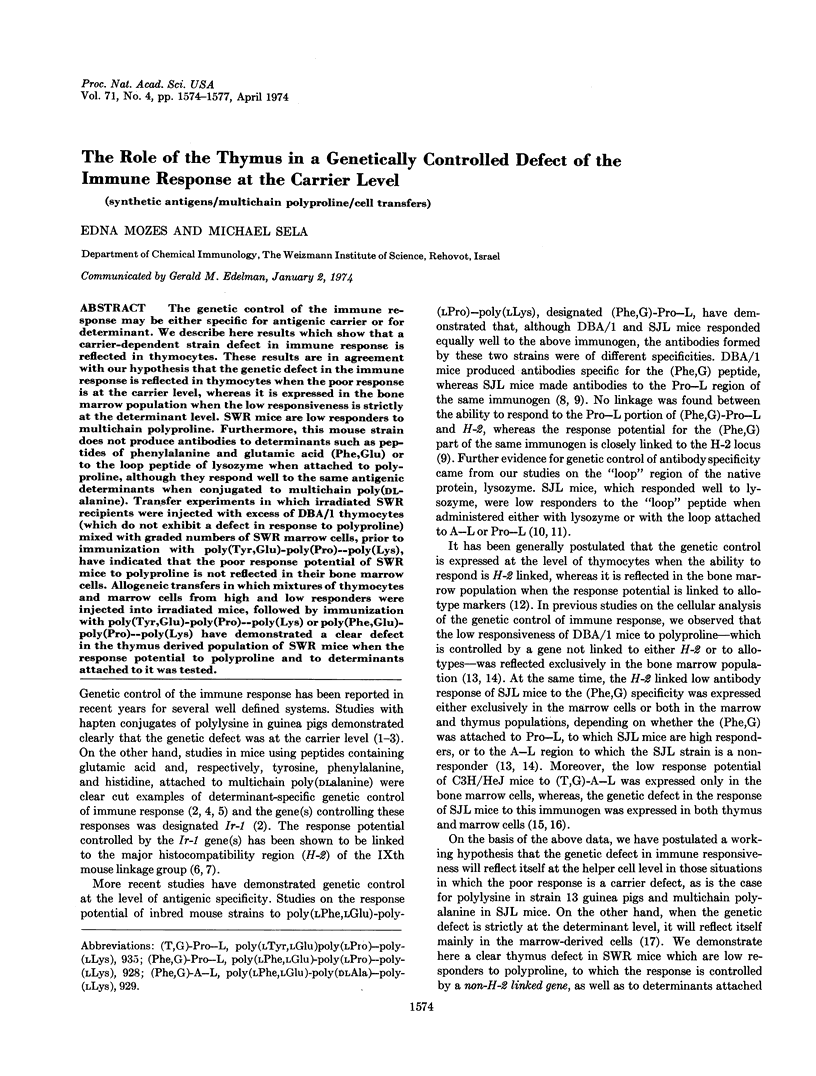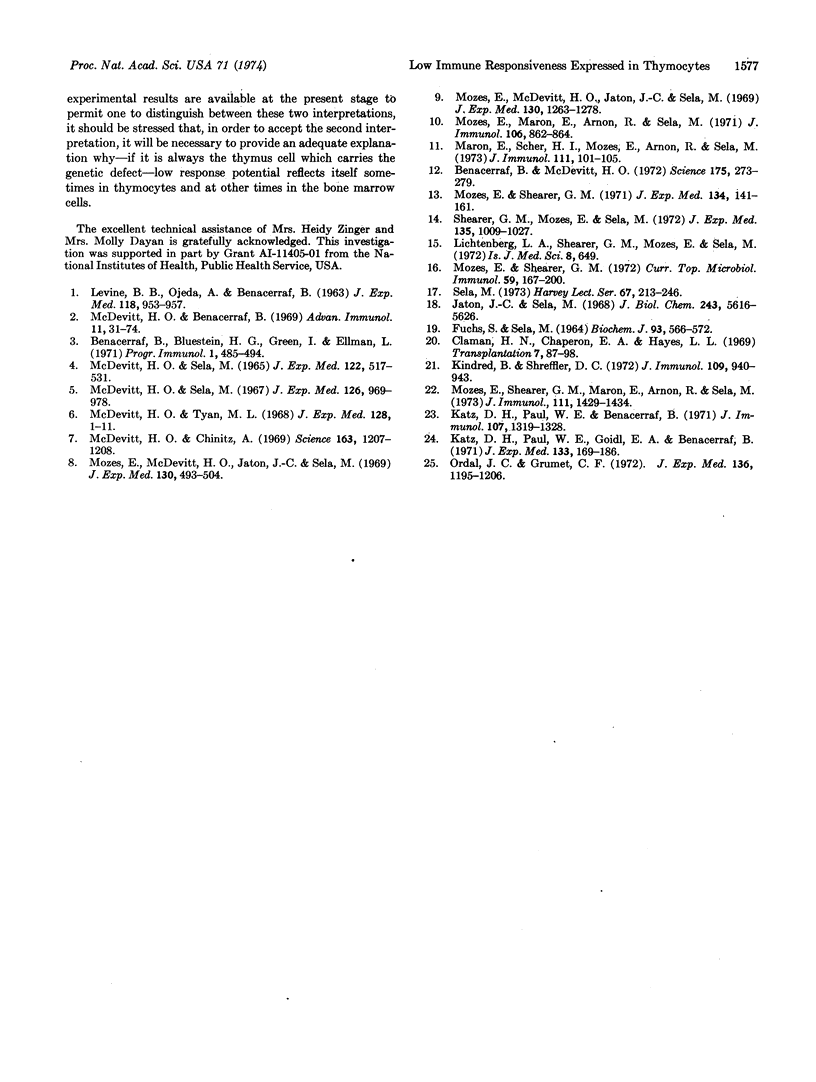Abstract
The genetic control of the immune response may be either specific for antigenic carrier or for determinant. We describe here results which show that a carrier-dependent strain defect in immune response is reflected in thymocytes. These results are in agreement with our hypothesis that the genetic defect in the immune response is reflected in thymocytes when the poor response is at the carrier level, whereas it is expressed in the bone marrow population when the low responsiveness is strictly at the determinant level. SWR mice are low responders to multichain polyproline. Furthermore, this mouse strain does not produce antibodies to determinants such as peptides of phenylalanine and glutamic acid (Phe,Glu) or to the loop peptide of lysozyme when attached to polyproline, although they respond well to the same antigenic determinants when conjugated to multichain poly(DL-alanine). Transfer experiments in which irradiated SWR recipients were injected with excess of DBA/1 thymocytes (which do not exhibit a defect in response to polyproline) mixed with graded numbers of SWR marrow cells, prior to immunization with poly(Tyr,Glu)-poly(Pro)--poly(Lys), have indicated that the poor response potential of SWR mice to polyproline is not reflected in their bone marrow cells. Allogeneic transfers in which mixtures of thymocytes and marrow cells from high and low responders were injected into irradiated mice, followed by immunization with poly(Tyr,Glu)-poly(Pro)--poly(Lys) or poly(Phe,Glu)-poly(Pro)--poly(Lys) have demonstrated a clear defect in the thymus derived population of SWR mice when the response potential to polyproline and to determinants attached to it was tested.
Keywords: synthetic antigens, multichain polyproline, cell transfers
Full text
PDF



Selected References
These references are in PubMed. This may not be the complete list of references from this article.
- Benacerraf B., McDevitt H. O. Histocompatibility-linked immune response genes. Science. 1972 Jan 21;175(4019):273–279. doi: 10.1126/science.175.4019.273. [DOI] [PubMed] [Google Scholar]
- Claman H. N., Chaperon E. A., Hayes L. L. Thymus-marrow immunocompetence. IV. The growth and immunocompetence of transferred marrow, thymus, and spleen cells in parent and F1 hybrid mice. Transplantation. 1969 Feb;7(2):87–98. [PubMed] [Google Scholar]
- Fuchs S., Sela M. Antigenicity of some new synthetic polypeptides and polypeptidyl gelatins. Biochem J. 1964 Dec;93(3):566–572. doi: 10.1042/bj0930566. [DOI] [PMC free article] [PubMed] [Google Scholar]
- Jaton J. C., Sela M. Role of optical configuration in the immunogenicity and specificity of synthetic antigens derived from multichain polyproline. J Biol Chem. 1968 Nov 10;243(21):5616–5626. [PubMed] [Google Scholar]
- Katz D. H., Paul W. E., Benacerraf B. Carrier function in anti-hapten antibody responses. V. Analysis of cellular events in the enhancement of antibody responses by the "allogeneic effect" in DNP-OVA-primed guinea pigs challenged with a heterologous DNP-conjugate. J Immunol. 1971 Nov;107(5):1319–1328. [PubMed] [Google Scholar]
- Katz D. H., Paul W. E., Goidl E. A., Benacerraf B. Carrier function in anti-hapten antibody responses. 3. Stimulation of antibody synthesis and facilitation of hapten-specific secondary antibody responses by graft-versus-host reactions. J Exp Med. 1971 Feb 1;133(2):169–186. doi: 10.1084/jem.133.2.169. [DOI] [PMC free article] [PubMed] [Google Scholar]
- Kindred B., Shreffler D. C. H-2 dependence of co-operation between T and B cells in vivo. J Immunol. 1972 Nov;109(5):940–943. [PubMed] [Google Scholar]
- LEVINE B. B., OJEDA A., BENACERRAF B. STUDIES ON ARTIFICIAL ANTIGENS. III. THE GENETIC CONTROL OF THE IMMUNE RESPONSE TO HAPTEN-POLY-L-LYSINE CONJUGATES IN GUINEA PIGS. J Exp Med. 1963 Dec 1;118:953–957. doi: 10.1084/jem.118.6.953. [DOI] [PMC free article] [PubMed] [Google Scholar]
- Maron E., Scher H. I., Mozes E., Arnon R., Sela M. Genetic control of immune response toward the loop region of lysozyme. J Immunol. 1973 Jul;111(1):101–105. [PubMed] [Google Scholar]
- McDevitt H. O., Benacerraf B. Genetic control of specific immune responses. Adv Immunol. 1969;11:31–74. doi: 10.1016/s0065-2776(08)60477-0. [DOI] [PubMed] [Google Scholar]
- McDevitt H. O., Chinitz A. Genetic control of the antibody response: relationship between immune response and histocompatibility (H-2) type. Science. 1969 Mar 14;163(3872):1207–1208. doi: 10.1126/science.163.3872.1207. [DOI] [PubMed] [Google Scholar]
- McDevitt H. O., Sela M. Genetic control of the antibody response. I. Demonstration of determinant-specific differences in response to synthetic polypeptide antigens in two strains of inbred mice. J Exp Med. 1965 Sep 1;122(3):517–531. doi: 10.1084/jem.122.3.517. [DOI] [PMC free article] [PubMed] [Google Scholar]
- McDevitt H. O., Sela M. Genetic control of the antibody response. II. Further analysis of the specificity of determinant-specific control, and genetic analysis of the response to (H,G)-A--L in CBA and C57 mice. J Exp Med. 1967 Nov 1;126(5):969–978. doi: 10.1084/jem.126.5.969. [DOI] [PMC free article] [PubMed] [Google Scholar]
- McDevitt H. O., Tyan M. L. Genetic control of the antibody response in inbred mice. Transfer of response by spleen cells and linkage to the major histocompatibility (H-2) locus. J Exp Med. 1968 Jul 1;128(1):1–11. [PMC free article] [PubMed] [Google Scholar]
- Mozes E., Maron E., Arnon R., Sela M. [Strain-dependent differences in the specificity of antibody responses toward lysozyme]. J Immunol. 1971 Mar;106(3):862–864. [PubMed] [Google Scholar]
- Mozes E., McDevitt H. O., Jaton J. C., Sela M. The genetic control of antibody specificity. J Exp Med. 1969 Dec 1;130(6):1263–1278. doi: 10.1084/jem.130.6.1263. [DOI] [PMC free article] [PubMed] [Google Scholar]
- Mozes E., McDevitt H. O., Jaton J. C., Sela M. The nature of the antigenic determinant in a genetic control of the antibody response. J Exp Med. 1969 Sep 1;130(3):493–504. doi: 10.1084/jem.130.3.493. [DOI] [PMC free article] [PubMed] [Google Scholar]
- Mozes E., Shearer G. M. Contribution of bone marrow cells and lack of expression of thymocytes in genetic controls of immune responses for two immunopotent regions within poly-(Phe,Glu)-poly-Pro--poly-Lys in inbred mouse strains. J Exp Med. 1971 Jul 1;134(1):141–161. doi: 10.1084/jem.134.1.141. [DOI] [PMC free article] [PubMed] [Google Scholar]
- Mozes E., Shearer G. M. Genetic control of immune responses. Curr Top Microbiol Immunol. 1972;59:167–200. doi: 10.1007/978-3-642-65444-2_6. [DOI] [PubMed] [Google Scholar]
- Mozes E., Shearer G. M., Maron E., Arnon R., Sela M. Cellular studies of the genetic control of immune response toward the loop region of lysozyme. J Immunol. 1973 Nov;111(5):1429–1434. [PubMed] [Google Scholar]
- Ordal J. C., Grumet F. C. Genetic control of the immune response. The effect of graft-versus-host reaction on the antibody response to poly-L(Tyr, Glu)-poly-D,L-Ala--poly-L-Lys in nonresponder mice. J Exp Med. 1972 Nov 1;136(5):1195–1206. doi: 10.1084/jem.136.5.1195. [DOI] [PMC free article] [PubMed] [Google Scholar]
- Sela M. Antigen design and immune response. Harvey Lect. 1973;67:213–246. [PubMed] [Google Scholar]
- Shearer G. M., Mozes E., Sela M. Contribution of different cell types to the genetic control of immune responses as a function of the chemical nature of the polymeric side chains (poly-L-prolyl and poly-DL-alanyl) of synthetic immunogens. J Exp Med. 1972 May 1;135(5):1009–1027. doi: 10.1084/jem.135.5.1009. [DOI] [PMC free article] [PubMed] [Google Scholar]


